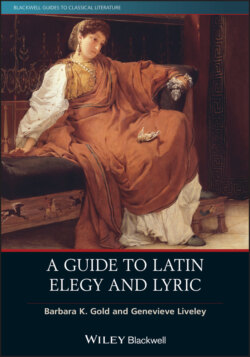Читать книгу A Guide to Latin Elegy and Lyric - Barbara K. Gold - Страница 12
Literary Contexts for Lyric: Genre and Canon
ОглавлениеIn Homer we find bards reciting epic poetry accompanied by the lyre (Odyssey 8.66) and archaic Greek poets such as Alcaeus and Sappho are supposed to have sung their lyric poetry to live audiences accompanied – just as the name suggests – by the music of a lyre. However, it wasn’t until much later, in the Hellenistic period (the historical period between the death of Alexander the Great in 323 bce and the birth of the Roman Empire in 31 bce), that lyric poetry came to be defined essentially by its meter. Or rather, by its meters – plural. For, unlike epic (which is defined as poetry written in hexameter verse) and elegy (which is written in couplets made up of paired lines of verse, namely a hexameter line followed by a pentameter line), lyric poetry uses lots of different meters. Some of these are named after the ancient Greek poets who originally composed the first known lyric poetry: Alcaeus, Alcman, Anacreon, Bacchylides, Ibycus, Pindar, Sappho, Simonides, and Stesichorus. In fact, these nine poets came to represent a formal lyric canon, and lyric poetry came to be quite loosely defined as anything written by these poets or in the meters they employed. This means that poetry described as “Greek lyric” verse covers a wide range of topics and embraces a wide variety of different styles. Some Greek lyrics celebrated the great achievements of famous men (for example, Pindar’s victory odes), some were written to be sung by a chorus of young men or women in ceremonial situations (such as Alcman’s Partheneion), and some expressed the intimate thoughts and emotions of the poets, who would sing in the first-person voice – telling of love and loss, and of their hopes and fears (such as the lyrics of Alcaeus and Sappho). Cicero may reportedly have complained that life was too short to read all the works of the Greek lyric poets (Seneca Epistles 49.5), but these Greek lyric styles would have a profound influence upon Roman lyric poetry, and the writings of Catullus and Horace – the only two Roman lyric poets whose work has survived – were decisively shaped by this Greek lyric tradition (see Chapters 2 and 3).
The earliest surviving Roman lyric poetry is found in Latin comedy and a few extant fragments of Latin tragedy – typically in the form of a song (Plautus’ third to second century bce comedies) or a chorus (Ennius’ second century bce tragedies). It is not until the early first century bce that we find the Latin poet Laevius apparently experimenting with a more personal, subjective style of lyric writing (familiar from the Greek lyric poets Alcaeus and Sappho) in his collection of Erotopaegnia (Love Songs). This work is now lost but seems to have included a lyric treatment of love stories from the mythic tradition. It is easy to see how such a collection might have influenced lyric (and, indeed, elegiac) poets in their later re-workings of such mythological stories, but the direct influence of the early dramatic lyric composition upon later lyric poetry is hard to assess. Nevertheless, these early theatrical, performative origins of Latin lyric should not be ignored. For they serve to remind us that Latin poetry was not simply or silently read in the Roman world, it was also performed.
